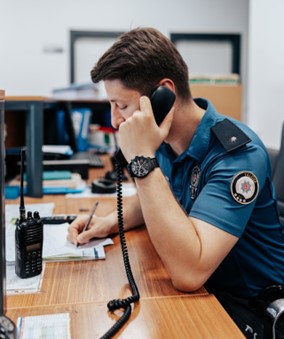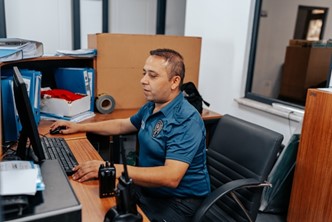
The design and construction of police facilities play a pivotal role in supporting the operational efficiency of law enforcement agencies while fostering community integration and enhancing public perception. Modern police stations are more than just buildings; they are hubs of activity where officers work, interact with the public, and coordinate responses to emergencies. James Vafeades of Long Island explores the principles of effective design, architectural innovations, and the importance of community engagement in creating police facilities that meet both operational needs and community expectations.
Principles of Effective Design and Construction
Designing a police facility involves careful consideration of various factors to ensure functionality, safety, and efficiency. Key principles include:
Functionality: Police stations are dynamic environments that house administrative offices, holding cells, interrogation rooms, evidence storage, and training facilities. Effective design ensures that these spaces are logically organized, easily accessible, and conducive to efficient workflow.
Security: Security is paramount in police facility design to protect officers, detainees, and the public. Features such as controlled access points, surveillance systems, secure perimeter fencing, and hardened entryways are critical components of secure facility design.
Flexibility: Flexibility in design allows police stations to adapt to evolving operational needs and technological advancements. Modular layouts, multipurpose rooms, and adaptable spaces facilitate efficient use of resources and accommodate future growth or changes in policing strategies.
Sustainability: Incorporating sustainable building practices, such as energy-efficient systems, renewable materials, and environmentally friendly design elements, not only reduces operational costs but also demonstrates a commitment to environmental stewardship.
Architectural Trends and Innovations
Recent advancements in architectural design have transformed the landscape of police facilities, focusing on enhancing functionality, aesthetics, and community engagement:
Community Policing Centers: Many modern police stations integrate community policing centers that serve as accessible hubs for community members to interact with officers, attend meetings, and access resources. These centers promote transparency, build trust, and encourage collaboration between law enforcement and residents.
Natural Light and Open Spaces: Incorporating natural light, open floor plans, and communal areas creates a welcoming environment for both officers and visitors. These design elements improve morale, reduce stress, and enhance communication within the facility.
Technological Integration: Advanced technology, including digital surveillance systems, communication networks, and smart building features, enhances operational efficiency and situational awareness. Integrating technology into facility design supports data-driven policing strategies and enhances officer safety.
Accessibility and Inclusivity: Designing police facilities with accessible entrances, ADA-compliant amenities, and inclusive spaces ensures equitable access for all community members, including individuals with disabilities or special needs. This promotes inclusivity and demonstrates respect for diversity within the community.
Importance of Community Engagement
Community engagement is a cornerstone of effective police facility design, ensuring that the needs and expectations of residents are incorporated into the planning process:
Stakeholder Input: Engaging community stakeholders, including residents, local businesses, advocacy groups, and civic leaders, solicits valuable feedback on facility design preferences, safety concerns, and community priorities. This collaborative approach fosters mutual understanding and promotes community buy-in.
Public Perception: Well-designed police facilities contribute to positive public perception by reflecting transparency, accessibility, and responsiveness to community needs. Facilities that blend into the neighborhood architecture and provide welcoming spaces for public interaction enhance trust and cooperation between police and residents.
Educational Outreach: Hosting community meetings, public forums, and educational sessions during the planning phase educates residents about the purpose and benefits of new police facilities. Transparent communication builds support for the project and addresses any concerns or misconceptions among community members.

Case Studies in Effective Facility Design
Several jurisdictions have successfully implemented innovative approaches to police facility design:
Los Angeles Police Department (LAPD) Headquarters: The LAPD Headquarters incorporates sustainable building practices, advanced technology systems, and community meeting spaces. It serves as a model for integrating operational efficiency with community engagement in a dense urban environment.
Seattle Police Department (SPD) North Precinct: The SPD North Precinct features a community room, public artwork installations, and interactive displays that celebrate local history and culture. This design promotes community involvement and enhances the precinct’s role as a neighborhood resource.
Austin Police Department (APD) Substations: APD has developed modern substations with energy-efficient design, interactive community spaces, and neighborhood-specific artwork. These substations support community-oriented policing strategies and strengthen relationships between officers and residents.
Conclusion
In conclusion, the design and construction of police facilities are critical components of modern law enforcement strategies that prioritize functionality, security, and community integration. By adhering to principles of effective design, embracing architectural innovations, and engaging with stakeholders, police agencies can create facilities that enhance operational capabilities, foster positive relationships with the public, and promote a safer, more inclusive community. As law enforcement evolves to meet the challenges of the 21st century, well-designed police facilities serve as foundational pillars in building trust, enhancing transparency, and supporting collaborative partnerships between police departments and the communities they serve.